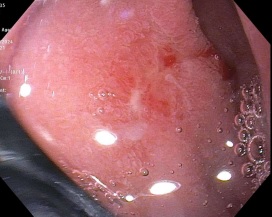Tuesday Poster Session
Category: GI Bleeding
P5287 - A Silent Threat Acute Immune Thrombocytopenic Purpura Manifesting as Severe Upper Gastrointestinal Bleeding
Tuesday, October 28, 2025
10:30 AM - 4:00 PM PDT
Location: Exhibit Hall

Bishoy Boulus Elkoumes, MD (he/him/his)
NYC Health + Hospitals/South Brooklyn Health
Brooklyn, NY
Presenting Author(s)
Bishoy Boulus Elkoumes, MD1, Amr Ibrahim, MD1, Muhammad Hammad Ul Hassan, MD1, Joshua Diaz, MD2, Michael Bernstein, MD1
1NYC Health + Hospitals/South Brooklyn Health, Brooklyn, NY; 2South brooklyn Health, Brooklyn, NY
Introduction: Idiopathic thrombocytopenic purpura (ITP) is a rare, but benign, autoimmune hematological disorder characterized by low platelet counts, secondary to immune-mediated platelet destruction. It might result in a higher susceptibility to bleeding, with a potential for life-threatening complications such as gastrointestinal bleeding (GIB) and intracranial hemorrhage. ITP, either acute or chronic, is a serious clinical challenge due to the bleeding risk, particularly with critically low platelet counts. The incidence of ITP is 50 cases/million individuals per year. Although the overall risk of GIB in patients with ITP is low (1-2%), but it can be associated with high mortality.
Case Description/
Methods: A 70-year-old female with a history of chronic immune thrombocytopenic purpura (ITP), managed with intermittent platelet transfusions for platelet counts < 30,000/μL, presented to the hospital with hematemesis and melena associated with fatigue for 3 days. She was not on any antiplatelets or anticoagulants, and had no prior peptic ulcer or liver disease.
Physical examination revealed mild pallor and epigastric tenderness.
While vital signs remained stable, labs demonstrated a hemoglobin drop from 13 g/dL to 8.8 g/dL, and a platelet count of 21,000/μL.
The patient was managed by red blood cell and platelet transfusion as well as intravenous immunoglobulin and high-dose steroids to improve the platelet count by preventing autoimmune platelet destruction.
Endoscopy revealed a non-bleeding gastric ulcer, likely the cause of the GIB. No varices or erosive disease was found.
Her platelet count increased to 101,000/μL, and hemoglobin stabilized at 9.2 g/dL. The patient remained stable without hematemesis, melena or signs of rebleeding.
Discussion: Although most ITP cases are chronic and managed with platelet transfusions as needed, patients with severe thrombocytopenia are at higher risk for life-threatening bleed.
Radio-labeled platelet survival studies in healthy individuals and thrombocytopenic patients estimate that 7-8 × 10⁹/L platelets are required for adequate vascular hemostasis.
A significant 1977 study describing the relationship between severe thrombocytopenia and bleeding in various thrombocytopenic patients established that significant bleed rarely occurred with platelet counts > 30×10⁹/L, and major bleed was typically observed only with platelet counts < 10×10⁹/L.
Current clinical guidelines emphasize maintaining platelet counts above 50,000/μL to minimize the risk of severe hemorrhagic events.

Figure: Image 1: Endoscopy showing Non-Bleeding Duodenal Ulcer
Disclosures:
Bishoy Boulus Elkoumes indicated no relevant financial relationships.
Amr Ibrahim indicated no relevant financial relationships.
Muhammad Hammad Ul Hassan indicated no relevant financial relationships.
Joshua Diaz indicated no relevant financial relationships.
Michael Bernstein indicated no relevant financial relationships.
Bishoy Boulus Elkoumes, MD1, Amr Ibrahim, MD1, Muhammad Hammad Ul Hassan, MD1, Joshua Diaz, MD2, Michael Bernstein, MD1. P5287 - A Silent Threat Acute Immune Thrombocytopenic Purpura Manifesting as Severe Upper Gastrointestinal Bleeding, ACG 2025 Annual Scientific Meeting Abstracts. Phoenix, AZ: American College of Gastroenterology.
1NYC Health + Hospitals/South Brooklyn Health, Brooklyn, NY; 2South brooklyn Health, Brooklyn, NY
Introduction: Idiopathic thrombocytopenic purpura (ITP) is a rare, but benign, autoimmune hematological disorder characterized by low platelet counts, secondary to immune-mediated platelet destruction. It might result in a higher susceptibility to bleeding, with a potential for life-threatening complications such as gastrointestinal bleeding (GIB) and intracranial hemorrhage. ITP, either acute or chronic, is a serious clinical challenge due to the bleeding risk, particularly with critically low platelet counts. The incidence of ITP is 50 cases/million individuals per year. Although the overall risk of GIB in patients with ITP is low (1-2%), but it can be associated with high mortality.
Case Description/
Methods: A 70-year-old female with a history of chronic immune thrombocytopenic purpura (ITP), managed with intermittent platelet transfusions for platelet counts < 30,000/μL, presented to the hospital with hematemesis and melena associated with fatigue for 3 days. She was not on any antiplatelets or anticoagulants, and had no prior peptic ulcer or liver disease.
Physical examination revealed mild pallor and epigastric tenderness.
While vital signs remained stable, labs demonstrated a hemoglobin drop from 13 g/dL to 8.8 g/dL, and a platelet count of 21,000/μL.
The patient was managed by red blood cell and platelet transfusion as well as intravenous immunoglobulin and high-dose steroids to improve the platelet count by preventing autoimmune platelet destruction.
Endoscopy revealed a non-bleeding gastric ulcer, likely the cause of the GIB. No varices or erosive disease was found.
Her platelet count increased to 101,000/μL, and hemoglobin stabilized at 9.2 g/dL. The patient remained stable without hematemesis, melena or signs of rebleeding.
Discussion: Although most ITP cases are chronic and managed with platelet transfusions as needed, patients with severe thrombocytopenia are at higher risk for life-threatening bleed.
Radio-labeled platelet survival studies in healthy individuals and thrombocytopenic patients estimate that 7-8 × 10⁹/L platelets are required for adequate vascular hemostasis.
A significant 1977 study describing the relationship between severe thrombocytopenia and bleeding in various thrombocytopenic patients established that significant bleed rarely occurred with platelet counts > 30×10⁹/L, and major bleed was typically observed only with platelet counts < 10×10⁹/L.
Current clinical guidelines emphasize maintaining platelet counts above 50,000/μL to minimize the risk of severe hemorrhagic events.

Figure: Image 1: Endoscopy showing Non-Bleeding Duodenal Ulcer
Disclosures:
Bishoy Boulus Elkoumes indicated no relevant financial relationships.
Amr Ibrahim indicated no relevant financial relationships.
Muhammad Hammad Ul Hassan indicated no relevant financial relationships.
Joshua Diaz indicated no relevant financial relationships.
Michael Bernstein indicated no relevant financial relationships.
Bishoy Boulus Elkoumes, MD1, Amr Ibrahim, MD1, Muhammad Hammad Ul Hassan, MD1, Joshua Diaz, MD2, Michael Bernstein, MD1. P5287 - A Silent Threat Acute Immune Thrombocytopenic Purpura Manifesting as Severe Upper Gastrointestinal Bleeding, ACG 2025 Annual Scientific Meeting Abstracts. Phoenix, AZ: American College of Gastroenterology.
